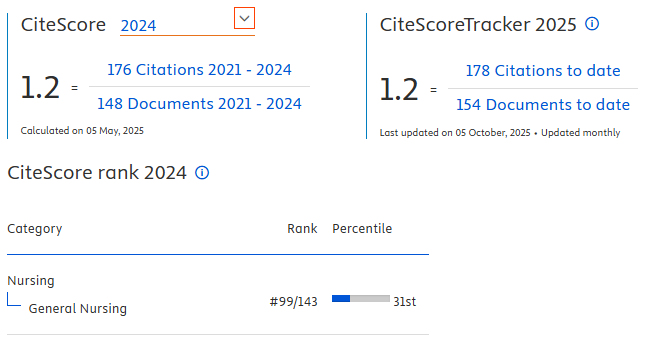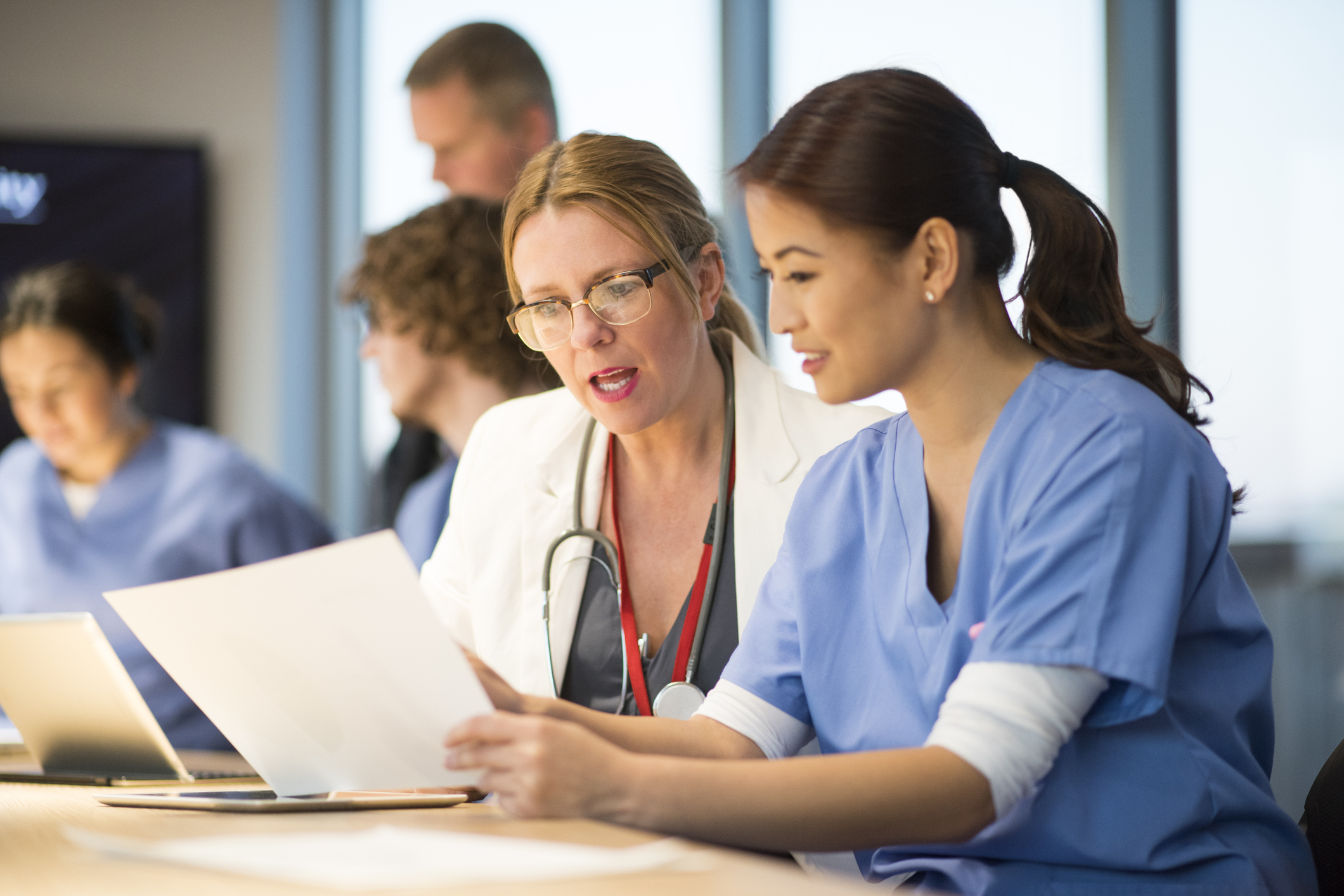The Impact of Independent of Activity Daily Living among Stroke Patients on Caregivers Burden
Downloads
Introduction:Weakness among stroke patients causes obstacles when fulfilling their activities in daily living (ADL). This condition also has an impact on the caregivers who provide daily care at home. The purpose of this study was to analyze the effect of independent ADL among the stroke patients on caregiver burden.
Methods: The study used an analytical design through a cross-sectional approach. The variables included independent ADL and caregiver burden. A sample of 120 caregivers was taken from 2 community health centers in Surabaya through simple random sampling. The instruments used were Zarit Burden's Interview Schedule and the Katz Index of Independent for ADL. Regression ordinal was used to analyze the influence of independent ADL among stroke patients on caregiver burden.
Results: The results showed that the caregiver who take care of stroke patients with severe functional impairment will feel burdened 3 times more than no burden. Post-stroke care at home through a rehabilitation program plays an important role in improving the condition of patients and their families at home, especially the caregivers.
Conclusion: Nurses in a community health center through the family health care pathway provide comprehensive bio-psycho-socio-spiritual care in the rehabilitation period as expected. They are expected to improve and maintain the fulfillment of human needs comprehensively for stroke patients and their caregivers, so the quality of life of stroke patients, caregivers and their families remains optimal.Asrul Sani, M. (2018). From Family Stress to Family Strengths. Read, (February).
Badan Penelitian, & dan Pengembangan Kesehatan, K. K. R. I. (2013). RISET KESEHATAN DASAR 2013.
Bakas, T., Clark, P. C., Kelly-hayes, M., King, R. B., Lutz, B. J., & Miller, E. L. (2014). Evidence for Stroke Family Caregiver and Dyad Interventions. Stroke, 45, 2836–2852. https://doi.org/10.1161/STR.0000000000000033
Björkdahl, A., Nilsson, í…. L., & Sunnerhagen, K. S. (2007). Can rehabilitation in the home setting reduce the burden of care for the next-of-kin of stroke victims? Journal of Rehabilitation Medicine, 39(1), 27–32. https://doi.org/10.2340/16501977-0001
Chow, S. K. Y., Wong, F. K. Y., & Poon, C. Y. F. (2007). Coping and caring: Support for family caregivers of stroke survivors. Journal of Clinical Nursing, 16(7 B), 133–143. https://doi.org/10.1111/j.1365-2702.2006.01711.x
Damawiyah, S. (2015). Pengaruh penerapan discharge planning dengan pendekatan family centered nursing terhadap motivasi dan kesiapan keluarga merawat pasien stroke pasca akut di RSI Surabaya.
Fadilah, N., Kusnanto, Nursalam, Minarti, & Asnani. (2018). Structural model of the factors related to the family resilience of stroke patients in Indonesia. Indian Journal of Public Health Research and Development, 9(11). https://doi.org/10.5958/0976-5506.2018.01721.7
Friedman, Marilyn M; Browden, Vicky R; Jones, E. G. (2010). Buku ajar keperawatan keluarga: riset, teori, & praktik (5th ed.). Jakarta: EGC.
Gbiri, C. A., Olawale, O. A., & Isaac, S. O. (2015). Stroke management: Informal caregivers' burdens and strians of caring for stroke survivors. Annals of Physical and Rehabilitation Medicine, 58(2), 98–103. https://doi.org/10.1016/J.REHAB.2014.09.017
Handayani, D. Y., & Dewi, D. E. (2009). Analisis kualitas hidup pasien dan keluarga pasca serangan stroke (dengan gejala sisa). Psycho Idea, Tahun 7 No, 35–44.
Hariyati, T. S., Sumarwati, M., & Handiyani, H. (n.d.). Pengaruh manajemen stress terhadap kesiapan pasien stroke dan keluarga dalam merencanakan perilaku adaptif pasca perawatan di rumah sakit. Jurnal Keperawatan Indonesia, 1–8, 13–17.
Karunia, E. (2016). Hubungan Antara Dukungan Keluarga dengan Kemandirian Activity of Daily Living (ADL) Pasca Stroke. Jurnal Berkala Epidemiologi, Vol. 4(September), 213–224. https://doi.org/10.20473/jbe.v4i2.2016.213
Kumar, Sg., Roy, G., & Kar, S. (2012). Disability and rehabilitation services in India: Issues and challenges. Journal of Family Medicine and Primary Care, 1(1), 69. https://doi.org/10.4103/2249-4863.94458
Munir, B. (2018). Neurologi Dasar (Edisi 2). Jakarta: Sagung Seto.
Ogunlana, M. O., Dada, O. O., Oyewo, O. S., Odole, A. C., & Ogunsan, M. O. (2014). Quality of life and burden of informal caregivers of stroke survivors. Hong Kong Physiotherapy Journal, 32(1), 6–12. https://doi.org/10.1016/j.hkpj.2013.11.003
Pambudi, H. A. (2009). Studi fenomenologis: kecemasan keluarga pada pasien stroke yang dirawat di ruang HND Santo Lukas RS St. Elisabeth Semarang. 1–15.
Pesantes, M. A., Brandt, L. R., Ipince, A., Miranda, J. J., & Diez-Canseco, F. (2017). An exploration into caring for a stroke-survivor in Lima, Peru: Emotional impact, stress factors, coping mechanisms and unmet needs of informal caregivers. ENeurologicalSci, 6, 33–50. https://doi.org/10.1016/J.ENSCI.2016.11.004
Ratnasari, P; Kristiyawati, S.P.; Solechan, A. (2015). Hubungan Antara Tingkat Ketergantungan Avtivity Daily Living Dengan Depresi Pada Pasien Stroke Di RSUD Tugurejo Semarang.
Rigby, H., Gubitz, G., & Phillips, S. (2009). A systematic review of caregiver burden following stroke. International Journal of Stroke, 4(4), 285–292. https://doi.org/10.1111/j.1747-4949.2009.00289.x
RISKESDAS. (2018). Hasil Utama Riset Kesehatan Dasar 2018. Kementrian Kesehatan Republik Indonesia, 1(1), 1–200. https://doi.org/1 Desember 2013
Setyoadi, S., & Wihastuti, T. A. (2018). Burnout Syndrome on Care Givers and The Fulfillment Needs of Care in The Post Stroke Patients at Physiotherapy Outpatient Ward in RST DR. Soepraoen. Jurnal Keperawatan, 9(2), 125. https://doi.org/10.22219/jk.v9i2.5208
Suprobo, K. A., Wiyono, N., & Setyanto, A. T. (2015). Pengaruh Supportive Group Therapy terhadap Caregiver Burden Pada Istri yang Berperan Sebagai Primary Caregiver Penderita Stroke. Jurnal Universitas Sebelas Maret, 1–12.
Vincent, C., Desrosiers, J., Landreville, P., & Demers, L. (2009). Burden of caregivers of people with stroke: Evolution and predictors. Cerebrovascular Diseases, 27(5), 456–464. https://doi.org/10.1159/000210092
Wahyuningsih, S. A. (2011). Pengaruh Terapi Suportif terhadap Kemampuan Keluarga Merawat Klien Gagal Ginjal Kronik (GGK) Yang Menjalani Hemodialisa di Rumah Sakit Pelni Jakarta.
Wallace, M., & Shelkey, M. (2006). Try This: Best Practices in Nursing Care to Older Adults Katz Index of Independence in Activities of Daily Living (ADL). Annals of Long Term Care, 14(11), 26–27.
Authors who publish with Jurnal Ners agree to the following terms:
- Authors transfer the Copyright and grant Jurnal Ners the right of first publication with the work simultaneously licensed under a Creative Commons Attribution 4.0 International License that allows others to remix, adapt and build upon the work with an acknowledgment of the work's authorship and of the initial publication in Jurnal Ners.
- Authors are permitted to copy and redistribute the journal's published version of the work (e.g., post it to an institutional repository or publish it in a book), with an acknowledgment of its initial publication in Jurnal Ners.
Jurnal Ners requires a formal written declaration and transfer of copyright from the author(s) for each article published. We, therefore, ask you to complete and return this form, retaining a copy for your own records. Your cooperation is essential and appreciated. Any delay will result in a delay in publication. The form can be downloaded HERE.
































